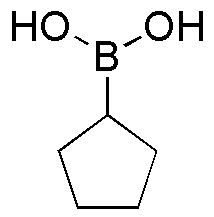Cyclopentylboronic acid is widely utilized in research focused on:
- Organic Synthesis: This compound is a valuable reagent in the synthesis of complex organic molecules, particularly in the formation of carbon-carbon bonds through Suzuki coupling reactions. Its unique structure allows for the efficient coupling of aryl halides with various nucleophiles.
- Pharmaceutical Development: In drug discovery, cyclopentylboronic acid is used to create boron-containing compounds that can enhance the efficacy of pharmaceuticals. Its ability to form stable complexes with various biomolecules makes it a key player in medicinal chemistry.
- Material Science: This chemical is employed in the development of advanced materials, such as polymers and nanomaterials, where boron functionality can improve mechanical properties and thermal stability.
- Bioconjugation: In biochemistry, it serves as a tool for attaching biomolecules, such as proteins or peptides, to surfaces or other molecules, facilitating the development of biosensors and targeted drug delivery systems.
- Environmental Applications: Cyclopentylboronic acid can be used in environmental chemistry for the detection and removal of pollutants. Its reactivity allows for the development of sensors that can identify trace amounts of harmful substances in various environments.
General Information
Properties
Safety and Regulations
Applications
Cyclopentylboronic acid is widely utilized in research focused on:
- Organic Synthesis: This compound is a valuable reagent in the synthesis of complex organic molecules, particularly in the formation of carbon-carbon bonds through Suzuki coupling reactions. Its unique structure allows for the efficient coupling of aryl halides with various nucleophiles.
- Pharmaceutical Development: In drug discovery, cyclopentylboronic acid is used to create boron-containing compounds that can enhance the efficacy of pharmaceuticals. Its ability to form stable complexes with various biomolecules makes it a key player in medicinal chemistry.
- Material Science: This chemical is employed in the development of advanced materials, such as polymers and nanomaterials, where boron functionality can improve mechanical properties and thermal stability.
- Bioconjugation: In biochemistry, it serves as a tool for attaching biomolecules, such as proteins or peptides, to surfaces or other molecules, facilitating the development of biosensors and targeted drug delivery systems.
- Environmental Applications: Cyclopentylboronic acid can be used in environmental chemistry for the detection and removal of pollutants. Its reactivity allows for the development of sensors that can identify trace amounts of harmful substances in various environments.
Documents
Safety Data Sheets (SDS)
The SDS provides comprehensive safety information on handling, storage, and disposal of the product.
Product Specification (PS)
The PS provides a comprehensive breakdown of the product’s properties, including chemical composition, physical state, purity, and storage requirements. It also details acceptable quality ranges and the product's intended applications.
Certificates of Analysis (COA)
Search for Certificates of Analysis (COA) by entering the products Lot Number. Lot and Batch Numbers can be found on a product’s label following the words ‘Lot’ or ‘Batch’.
*Catalog Number
*Lot Number
Certificates Of Origin (COO)
This COO confirms the country where the product was manufactured, and also details the materials and components used in it and whether it is derived from natural, synthetic, or other specific sources. This certificate may be required for customs, trade, and regulatory compliance.
*Catalog Number
*Lot Number
Safety Data Sheets (SDS)
The SDS provides comprehensive safety information on handling, storage, and disposal of the product.
DownloadProduct Specification (PS)
The PS provides a comprehensive breakdown of the product’s properties, including chemical composition, physical state, purity, and storage requirements. It also details acceptable quality ranges and the product's intended applications.
DownloadCertificates of Analysis (COA)
Search for Certificates of Analysis (COA) by entering the products Lot Number. Lot and Batch Numbers can be found on a product’s label following the words ‘Lot’ or ‘Batch’.
*Catalog Number
*Lot Number
Certificates Of Origin (COO)
This COO confirms the country where the product was manufactured, and also details the materials and components used in it and whether it is derived from natural, synthetic, or other specific sources. This certificate may be required for customs, trade, and regulatory compliance.


